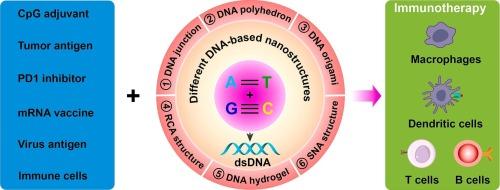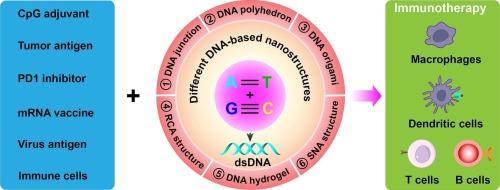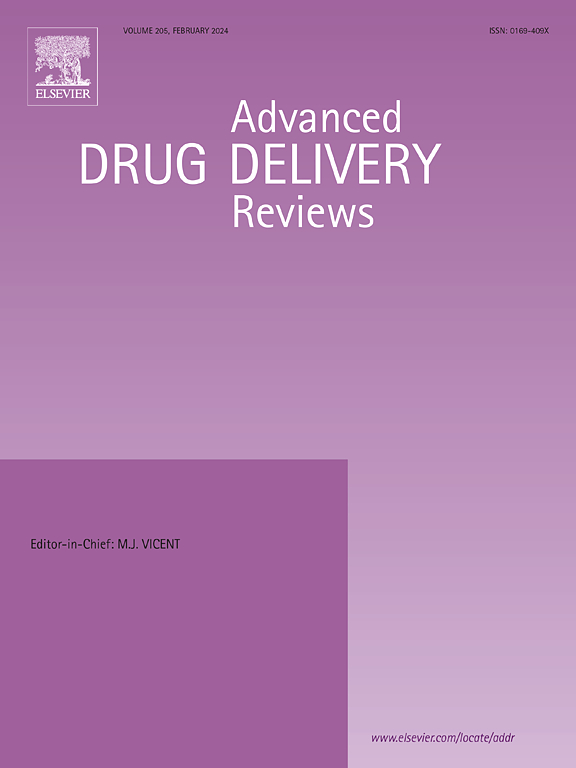Applications of DNA-based nanostructures in immunotherapy
IF 17.6
1区 医学
Q1 PHARMACOLOGY & PHARMACY
引用次数: 0
Abstract
DNA, as a carrier of genetic information, has further been efficiently utilized as a foundational element in creating diverse nanostructures of different shapes and sizes through precise base pairing. With spatial addressability, structural programmability, and remarkable biocompatibility, self-assembled DNA-based nanostructures have been broadly applied in various biomedical research areas, such as bio-imaging, disease diagnosis, and drug delivery. Of particular note, immunotherapy, known for its outstanding therapeutic efficacy, has garnered much attention. In this review, we highlight the recent applications of DNA-based nanostructures (including DNA junction, DNA polyhedron, DNA origami, RCA-based DNA structure, DNA hydrogel, and spherical nucleic acid) in immunotherapy (based on the delivery of CpG adjuvant, tumor antigen, PD1 inhibitor, mRNA vaccine, virus antigen, or direct regulating immune cells). Furthermore, the challenges and future prospects of DNA-based nanostructures for in vivo immunotherapy are discussed.


dna纳米结构在免疫治疗中的应用
DNA作为遗传信息的载体,通过精确的碱基配对,进一步有效地利用DNA作为基础元素,创造出不同形状和大小的纳米结构。基于dna的自组装纳米结构具有空间可寻址性、结构可编程性和显著的生物相容性,已广泛应用于生物成像、疾病诊断和药物传递等生物医学研究领域。尤其值得注意的是,以其突出的治疗效果而闻名的免疫疗法引起了人们的广泛关注。在这篇综述中,我们重点介绍了基于DNA的纳米结构(包括DNA连接、DNA多面体、DNA折纸、基于rca的DNA结构、DNA水凝胶和球形核酸)在免疫治疗中的最新应用(基于递送CpG佐剂、肿瘤抗原、PD1抑制剂、mRNA疫苗、病毒抗原或直接调节免疫细胞)。此外,还讨论了基于dna的纳米结构在体内免疫治疗中的挑战和未来前景。
本文章由计算机程序翻译,如有差异,请以英文原文为准。
求助全文
约1分钟内获得全文
求助全文
来源期刊
CiteScore
28.10
自引率
5.00%
发文量
294
审稿时长
15.1 weeks
期刊介绍:
The aim of the Journal is to provide a forum for the critical analysis of advanced drug and gene delivery systems and their applications in human and veterinary medicine. The Journal has a broad scope, covering the key issues for effective drug and gene delivery, from administration to site-specific delivery.
In general, the Journal publishes review articles in a Theme Issue format. Each Theme Issue provides a comprehensive and critical examination of current and emerging research on the design and development of advanced drug and gene delivery systems and their application to experimental and clinical therapeutics. The goal is to illustrate the pivotal role of a multidisciplinary approach to modern drug delivery, encompassing the application of sound biological and physicochemical principles to the engineering of drug delivery systems to meet the therapeutic need at hand. Importantly the Editorial Team of ADDR asks that the authors effectively window the extensive volume of literature, pick the important contributions and explain their importance, produce a forward looking identification of the challenges facing the field and produce a Conclusions section with expert recommendations to address the issues.

 求助内容:
求助内容: 应助结果提醒方式:
应助结果提醒方式:


